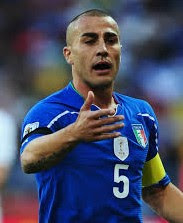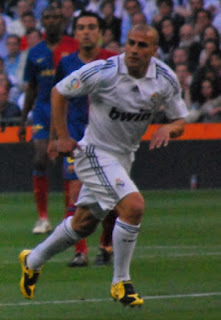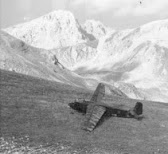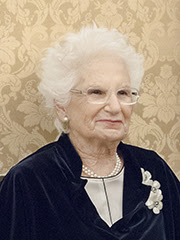Defender captained Azzurri to 2006 triumph
 |
Fabio Cannavaro in action at the
2006 World Cup finals |
The footballer and coach Fabio Cannavaro, who was captain of the Italy team that won the 2006 World Cup in Germany, was born on this day in 1973 in Naples.In a hugely successful playing career, the central defender was part of the excellent Parma team that won the UEFA Cup and the Coppa Italia under coach Alberto Malesani in the late 1990s, winning another Coppa Italia in 2002 with Pietro Carmignani in charge.
But his biggest glories were to come after he left Italy for Spain to play for Real Madrid under the Italian coach Fabio Capello, winning the La Liga title twice in 2006 and 2007.
His 136 appearances for the Azzurri made him the most capped outfield player in the history of the Italian national team (only goalkeeper Gianluigi Buffon has more caps in total) and the feat of winning La Liga and the World Cup in the same year helped him win the coveted Ballon d’Or, awarded annually by the magazine France Football to the player judged to be the best in Europe. He is only the third defender to be given the award, joining the company of Franz Beckenbauer and Matthias Sammer.
Cannavaro, who also played for Inter-Milan and Juventus, retired from playing in 2011 and has since coached teams in the United Arab Emirates and China, where he currently works for the Chinese Super League club Guangzhou Evergrande.
 |
Cannavaro in his days as a young
professional with Napoli |
The son of a bank clerk, Cannavaro learned to play football in the street with his brother, Paolo, who would also become a professional. A fanatical
Napoli supporter, he was a 13-year-old ball boy at the Stadio San Paolo when the club won the Serie A title for the first time in their history in 1987, thanks to the brilliance of their icon Diego Maradona.
His own talent earned him games for a suburban Neapolitan team at Bagnoli and it was while playing for them that he was spotted by a scout from Napoli. Soon he was turning out for Napoli’s youth team and earning an invitation to train alongside Maradona and the senior squad. A ball-winning midfield player at that time, he caused a stir in one training session when he launched a sliding tackle against the club’s prized asset that won the ball but made the coaching staff wince. Cannavaro was ticked off for being too aggressive but Maradona spoke up in his defence and reportedly gave him a pair of boots as a souvenir at the end of the session.
Cannavaro made his first-team debut for Napoli in 1993 at the age of 19. Despite standing only 5ft 9ins (1.75m), he was deployed as a centre-back alongside another of his heroes, Ciro Ferrera, after coach Claudio Ranieri determined that his anticipation, tackling, distribution and his ability to launch attacks from defensive more than compensated from his lack of height.
He might have made his career with his hometown club had Napoli not run into financial difficulties in the mid-1990s, obliging them to accept an offer of the equivalent of £6 million for him from Parma, whom he joined in the summer of 1995.
As well as enjoying trophy-winning success with the Emilia-Romagna club, of whom he was made captain not long after he arrived, he also played for two seasons alongside his brother, Paolo, who also made the move from Napoli to Parma, in 1999.
 |
Cannavaro with sports minister Giovanna Melandra, president Giorgio
Napolitano and coach Marcello Lippi at a night of celebration in Rome |
After his success with Parma, Cannavaro’s transfer value rocketed, to the extent that Inter paid €23 million (£14 million) for his services in 2002. His spell at the San Siro did not bring any trophies but his own value was barely diminished and he moved to Juventus in a deal worth €20 million (£13.6 million) in 2004.
The transfer to Turin reunited him with former Parma teammates Buffon and Lilian Thuram and, for a season, with his former Napoli idol Ferrara, although it was an ill-fated move. Juventus won the Serie A title in 2005 and 2006 under Capello’s astute management only to have the titles stripped after the so-called Calciopoli scandal, in which several clubs were found to have sought to influence the appointment of referees perceived as friendly to their cause. Juventus were relegated to Serie B as a consequence.
Cannavaro subsequently followed Capello to Madrid and enjoyed the most successful spell of his career. When he returned to Juventus in 2009 after three years in Spain he was not the player he was. Juve supporters turned on him both for his erratic form and for having turned his back on the club in 2006 and in 2010, after a disappointing World Cup in South Africa, left the club on a free transfer to join Al-Ahli in the UAE.
 |
Cannavaro enjoyed more success
in Spain with Real Madrid |
As an international player, Cannavaro had been part of
Cesare Maldini’s Italy Under-21 team, which won the European championships in 1994 and 1996, before being elevated to the senior national team in 1997. He starred in the Italy team that beat England 1-0 at Wembley, thanks to a
Gianfranco Zola goal.
Quickly establishing his place in the side, Cannavaro helped the Azzurri reach the quarter-finals of the 1998 World Cup and the final of the 2000 European championships, in which they lost to France, but was injured in the 2002 World Cup in Japan and South Korea, in which Italy lost to the latter in the round of 16.
Cannavaro succeeded Paolo Maldini as captain in 2002 and settled into the role as a natural leader. The European championships of 2004 were a disappointment but coach Marcello Lippi brought the team to its peak at the 2006 World Cup, the highlight of which was a 2-0 defeat of the hosts in the semi-finals, thanks to goals by Fabio Grosso and Alessandro Del Piero, with Cannavaro playing a key role in the second, launching an attack from a defensive position in the way that Ranieri identified during his formative years with Napoli.
A fractious final against France, famous for the sending-off of the French skipper Zinedine Zidane, was won on penalties, but Cannavaro’s performance in defence was hailed as decisive, earning him the nickname of the ‘Berlin Wall’ among Italy fans. Returning to Italy, Cannavaro held the trophy aloft at a rapturous night of celebration on the Circus Maximus in Rome.
He subsequently overtook Paolo Maldini’s record of 126 caps but after a disappointing World Cup in South Africa in 2010 announced his retirement from international football.
 |
Cannavaro set up a charity with
former teammate Ciro Ferrara
|
Following his final transfer to Al Ahli in the UAE, Cannavaro moved into coaching. Much of his post-playing career has been spent in China, where he won the 2019 Chinese Super League title with Guangzhou Evergrande and was briefly in charge of the China national team.
Cannavaro, the father of three children with his wife, Daniela, who he married in 1996, joined with Ciro Ferrara after they had finished playing to set up the Fondazione Cannavaro Ferrara, a charity aimed at helping to buy equipment for a cancer hospital in their native Naples.
He attracted controversy in 2015 when he, Daniela and Paolo were handed jail sentences of between four and 10 months when they re-entered property that had been seized by police during an investigation into the player’s tax affairs. They appealed against the verdict and the sentences were suspended.
Cannavaro’s son, Christian, has followed his father in becoming a player, currently turning out for another Campanian team, Benevento.
 |
The city of Parma is famous for its gastronomy
and is the home of Prosciutto di Parma (Parma ham) |
Travel tip:Parma, where Cannavaro enjoyed a successful spell early in his career, is an historic city in the Emilia-Romagna region, famous for its ham (Prosciutto di Parma) and cheese (Parmigiano-Reggiano), the true ‘parmesan’. The city was given as a duchy to Pier Luigi Farnese, the illegitimate son of Pope Paul III, and his descendants ruled Parma till 1731. The composer, Verdi, was born near Parma at Bussetto and the city has a prestigious opera house, the Teatro Regio.
 |
The Arch of Trajan is one of a number
of Roman relics in the city of Benevento |
Travel tip:
In ancient times,
Benevento, which can be found about 70km (43 miles) northeast of Naples, was one of the most important cities in southern Italy, along the Via Appia trade route between Rome and Brindisi. The town is in an attractive location surrounded by the Apennine hills, and while it suffered considerable damage during the Second World War, there are many Roman remains, including a triumphal arch erected in honour of Trajan and an amphitheatre, built by Hadrian, that held 10,000 spectators and is still in good condition. The cathedral of Santa Maria Assunta, originally built in the 13th century, has undergone major reconstruction work, while the original bronze doors for the cathedral are now kept inside the building.
Also on this day:
1506: The death of painter Andrea Mantegna
1583: The birth of composer Girolamo Frescobaldi
1808: The death of writer and literary critic Saverio Bettinelli
Home



























